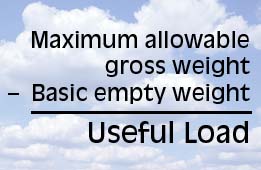| This ePilot Flight Training Edition is sponsored by

Advertisers
             
Do not reply to this e-mail. Got news? Contact ePilot. Having difficulty using this service? Visit the ePilot Frequently Asked Questions now at AOPA Online or write to [email protected].
Aircraft Owners and Pilots Association
421 Aviation Way
Frederick, MD 21701
Tel: 800/USA-AOPA or
301/695-2000
Copyright © 2006 AOPA. | Training Tips
| | TERM REVIEW: USEFUL LOAD
Your training aircraft has been down for maintenance. Now it is out of the shop and boasting new features. An avionics upgrade and cabin refinements top the list. Exciting.  But the alterations probably mean that the aircraft's "useful load" has changed. What's the useful load? Chapter 8 of the Pilot's Handbook of Aeronautical Knowledge defines "useful load" as "the weight of the pilot, copilot, passengers, baggage, usable fuel, and drainable oil. It is the basic empty weight subtracted from the maximum allowable gross weight. This term applies to general aviation aircraft only." But the alterations probably mean that the aircraft's "useful load" has changed. What's the useful load? Chapter 8 of the Pilot's Handbook of Aeronautical Knowledge defines "useful load" as "the weight of the pilot, copilot, passengers, baggage, usable fuel, and drainable oil. It is the basic empty weight subtracted from the maximum allowable gross weight. This term applies to general aviation aircraft only." Look at the aircraft's weight and balance information-it's the "W" in the ARROW acronym that reminds you what documents must be on board-and record the new numbers. Use them in all future loading calculations. If useful load has been reduced, it means that the new comforts come at the price of less loading capacity being available for other items. The work should be accompanied by updated on-board weight and balance documents. "On older aircraft especially, there may be many pages pertaining to weight and balance because with each modification of the airframe and avionics, a new weight and balance entry must be recorded. Make sure the latest such record is aboard, not only to satisfy legal requirements but also to compute an accurate weight and balance for the flight," Mark Twombly wrote in the December 2004 AOPA Flight Training column, "What It Looks Like: ARROW." For instance, if your aircraft were subject to an FAA ramp inspection, or if a flight-test examiner asked you to demonstrate if it complies with its weight and balance documents, you would have to produce the documents. Never use generic weight-and-balance figures published in an off-the-shelf pilot's operating handbook for your make and model aircraft when calculating loading and center of gravity-these numbers are for demonstration purposes only. The importance of accurate loading calculations and the risks of failing to compute them are discussed in the December 26, 2003, Training Tips article, "A Reasonable Balance." Enjoy your aircraft's new features. Usually the additional pilot comfort and aircraft capability make up for the small reduction in useful load.
| Your Partner in Training
| | Students tell us that one of the most valuable benefits of their free six-month membership is AOPA's Real-Time Flight Planner. The Real-Time Flight Planner allows you to overlay your route with active temporary flight restrictions (TFRs) and current weather, tap into AOPA's Airport Directory Online for the latest information on 5,500 public-use airports and 7,000 FBOs, plan a route while your flight plan and navigation log are created automatically-ready to print in kneeboard format and to file online with DUAT-and more. Do you have a question? Call the experienced pilots in AOPA's Pilot Information Center at 800/USA-AOPA. They're available to take your calls weekdays 8:30 a.m. to 6 p.m. Eastern. As an AOPA Flight Training member, you have access to all of the features within AOPA Online and AOPA Flight Training Online. Login information is available online.
| Flight Training News
| | AOPA ANNOUNCES SCHOLARSHIPS FOR CIVIL AIR PATROL CADETS
Two Civil Air Patrol members will be able to earn a private pilot certificate thanks to financial support from AOPA. The association announced on November 9 during AOPA Expo 2006 that it is providing $10,000 total for one cadet and one senior member to complete flight training. "We're thrilled to encourage new young pilots," said Sharon Krager, AOPA senior vice president of membership marketing. "Working with the Civil Air Patrol is a great way to reach prospective pilots." Civil Air Patrol members range from 12 to 21 years of age. CHECK YOUR MANEUVERING FLIGHT SKILLS WITH ASF SAFETY QUIZ
Maneuvering occurs every time you fly. It's more than aerobatics and buzzing; maneuvering flight includes ground reference maneuvers, steep turns, and even normal traffic patterns. Maneuvering flight has the highest fatality rate of any pilot-related accident. With the latest AOPA Air Safety Foundation Safety Quiz, you can test your knowledge on such questions as where in the traffic pattern are you at most risk, what your options are if your engine fails on climbout, and whether parachutes are required for all aerobatic maneuvers. Each Safety Quiz offers a quick, easy, and interactive way to assess and expand your knowledge. Plus, you can earn a chance to win a Sporty's Air-Scan V Aviation Radio/Scanner. Already taken this one? Challenge yourself with another Safety Quiz topic in the "Previous Quizzes" section. PEGASUS INTERACTIVE UNVEILS NEW PRODUCTS AT AOPA EXPO
Pegasus Interactive announced three new products in its line of computer-based aviation training products. The first, a new PC-based program called VFliterCFI iTools, is a suite of multimedia-based modules designed to enhance student training. The modules include navigation and holding tools, a VFR plotter, a circular flight computer, and an approach lighting and glideslope trainer. CFI iTools sells for $34.95. The second product is a PC-based program designed to help pilots determine safe aircraft loading. The VFlite Weight & Balance Visualizer displays CGs and warns pilots if their aircraft would be loaded out of limits. Available for a wide variety of single-engine aircraft, the product costs $39.95. Pegasus also announced it has begun shipping a new computer-based training program for the Garmin GPSmap 496. The VFlite GPSmap 496 Interactive Guide provides scenario-based simulation training and uses a hands-on approach. An emulator provides on-screen prompts and real-time feedback to enhance the learning process. The interactive guide sells for $59.95. All three products are distributed on Windows-compatible CD-ROMs and are also available at the company's Web site.
| Inside AOPA
| | EXPERIENCE EXPO HIGHLIGHTS ON AOPA ONLINE
In case you missed us at AOPA Expo last week in Palm Springs, California, it's not too late to experience the big show. We've added some additional stories and multimedia content to our Virtual Expo Web page. We'll see you next year in Hartford, Connecticut. HAVE YOU UPDATED YOUR AOPA MEMBER PROFILE?
To make the most of your membership and allow us to serve you better, please visit AOPA Online and update your personal member profile.
| Training Products
| | FLIGHT SIMULATION FOR FUN...AND TRAINING
Many of today's new pilots start their aerial adventures via the virtual skyways of personal-computer simulation games such as Microsoft Flight Simulator, and many pilots say that these programs help them to hone skills or remain proficient. Former Microsoft Games executive Bruce Williams has written a book on that very subject. Microsoft Flight Simulator as a Training Aid: A Guide for Pilots, Instructors, and Virtual Aviators was recently released by Aviation Supplies and Academics. The book, which details for pilots of all skill levels how to exploit the benefits of Microsoft Flight Simulator for training and proficiency purposes, is available for $29.95 through ASA. Note: Products listed have not been evaluated by ePilot editors unless otherwise noted. AOPA assumes no responsibility for products or services listed or for claims or actions by manufacturers or vendors.
| | Final Exam | | Question: What causes drag? Answer: There are primarily two types of drag, "induced" and "parasite," which create a combined total impact on airplane performance. Induced drag is a byproduct of lift, which results in wingtip vortices that increase the downwash behind the airplane's wings. The use of flaps, change of angle of attack, and deflection of the control surfaces all increase induced drag. Parasite drag, which is normally made up of form, interference, and skin friction drag, is created by the disturbance of the airflow around the airframe by items such as its skin, antennas, landing gear, and air gaps located between control surfaces and airframe. Induced drag will decrease and parasite drag will increase as speed increases. For more information, review Thomas A. Horne's article, "The Four Forces," on AOPA Online. Got a question for our technical services staff? E-mail to [email protected] or call the Pilot Information Center, 800/872-2672. Don't forget the online archive of "Final Exam" questions and answers, searchable by keyword or topic.
| Picture Perfect
| Looking for some really fabulous aviation photography? All the air-to-air photos and beautifully detailed ground images used by AOPA Pilot magazine over the years are yours at the click of a mouse button. Download your favorite images to use for wallpaper, send an e-postcard, or order prints online. For more details, see AOPA Online.
| Weekend Weather
| See the current weather on AOPA Online, provided by Meteorlogix.
| ePilot Calendar
| UPCOMING FLYING DESTINATIONS:
Denver, CO. A seminar, "The Stories Clouds Tell," takes place November 18 at Jeffco (BJC). Cleon Biter, a meteorologist for 44 years, will discuss cloud formation, cloud classification, and the effect of clouds on aircraft operations. Contact Chris Lucas, 303/449-1736, or visit the Web site. Meadville, PA. A Winter Flying Safety Program takes place November 21 at Port Meadville (GKJ). Sponsored by EAA Chapter 1194 and the Allegheny FSDO. FAA Wings credit. Contact James L. Murray, 814/382-4878. To submit an event to the calendar or to search all events visit AOPA Online. For airport details, see AOPA's Airport Directory Online. FLIGHT INSTRUCTOR REFRESHER CLINICS
The next AOPA Air Safety Foundation Flight Instructor Refresher Clinic is scheduled in Chicago, December 2 and 3. Clinics are also scheduled in Orlando, FL; Lincoln, NE; and Austin, TX; December 9 and 10. For a complete schedule, see AOPA Online. Can't make it in person? Sign up for the CFI Refresher Online.
| |